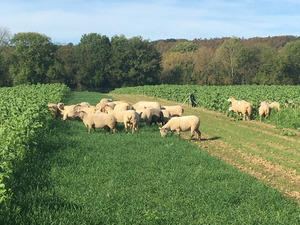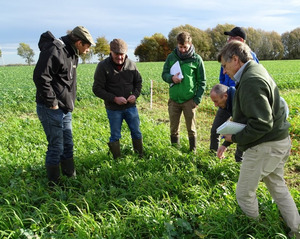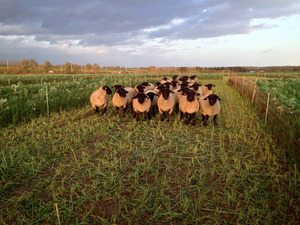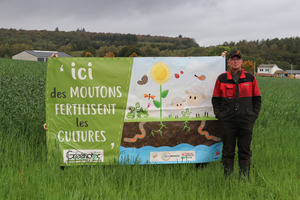Case study 4: Belgium: Service crops valorized through grazing
Cluster 1: Service crops
The case study focuses on cash crops grazed through innovative win-win partnerships between two types of farmers, which previously did not have any relationship: sheep farmers and arable farmers.
For sheep farmers, it is an opportunity to support the development of sheep production with new, quality forage. For arable farmers, the practice could have numerous advantages, including improved soil fertility, reduced pressure from pests, non-mechanical destruction of cash crops, incorporation of organic matter, and a better image of arable farmers.
The case study is now being expanded to also incorporate grazing in beets, rape and cereals.
What were the main problems underlying the emergence of the case study?
In 2015, grazing of cash crops was an emerging practice in Wallonia, which was only implemented by a few mixed arable and sheep producers. These farmers asked themselves and advisory bodies about the agronomic potential of the practice, following some contacts with and visits to Aube, France where mixed arable/sheep producers pioneered this practice.
Following these reflections, a student study was produced in collaboration with the farmers, Collège des Producteurs, and CRA-W to characterize the added value that sheep grazing on cover crops has for soil fertility. The first results highlight the interest and suitability of this practice to reduce deep soil compaction and to improve soil homogeneity without an impact on nutrient bioavailability for the next crop. Nevertheless, several questions remained, for example regarding the agro-economic interest for arable producers, economic performance for sheep producers linked to cover crop composition, potential of cover crop destruction, and environmental performance.
How was the problem addressed and which actors were involved?
58 % of Wallonia is a nitrate-vulnerable area, with mandatory cover crops on arable lands. Sheep farmers in Wallonia are often not arable farmers and vice versa. So, to develop diversification at a territorial scale, the case study focused on win-win partnerships between sheep farmers and arable farmers.
Most of the relevant stakeholders were involved in the case study:
- The collective of sheep producers and arable crop producers: we rely on the collective to help disseminate information.
- Mixed arable and sheep producers whose own sheep graze their crops
- Advisory bodies: Greenotec (conservation agriculture), Protect’eau (water protection), Fourrages Mieux (forage management), Eleveo (ovine advisor)
- RWDR (rural development network)
- Research bodies: CRA-W, UCL
Solution investigated
The case study did not have the means to deepen the scientific knowledge. Instead, the work of the case study focused mainly on the development and popularization of the practice, as well as on the overall study of the strengths and constraints of the practice. This is how we determined that one of the major advantage of the practice for the arable farmer would be an improved image among citizens and that new legislative constraints have appeared with the development of this new practice in Wallonia.
Expected outcome
The practice and the number of partnerships is constantly growing: from zero partnerships between sheep farmers and arable crop farmers in Wallonia before the case study was implemented to more than 38 during winter grazing season 2020 – 2021. More than 1250 hectares of arable land were grazed by sheep between August 2020 and February 2021 (compared to 75 hectares during winter grazing season 2017 – 2018). The development of the practice is now beyond the scope of the case study and some partnerships are thus not in contact with the case study team. However, arable farmers remain less interested in the practice than sheep farmers. It is therefore important to pay particular attention to their concerns. Nevertheless, the emergence of the practice is limited by sheep farmers since there are not enough sheep available in Wallonia to meet demand. Maintaining the development of the practice would therefore require an expansion in sheep farming in Wallonia.
The case study has raised awareness of the practice in the agricultural sector and secured funding for a 2-year research project (started in July 2019) that further explored interest by arable crop farmers in the practice. In addition to the agronomic, economic, environmental and social advantages of the practice, sheep grazing of cover crops contributes to arable farmers appreciation of cover crops: from a crop seen as mandatory and imposed to a crop seen as an opportunity within the agricultural rotation.
Today, a large part of cover crops in Wallonia are mono-species (often with mustard). As sheep grazing requires the establishment of multi-species cover crops, the practice will lead to more diverse cover crops.
Reflections on sheep grazing of other crops (beets, rapes, cereals) started at the end of 2018, and have led to new perspectives such as new partnerships and the discovery of unknown advantages of sheep grazing for crops.
Relevance to the DiverIMPACTS goals?
The case study has contributed to the development of diversification at the territorial level. It has promoted a sustainable practice for both arable farmers and sheep farmers.
Case study legacy
In order to allow new partnerships to form beyond the DiverIMPACTS project, a specific web exchange platform has been integrated into a website that facilitates sales between farmers, which is well known to farmers in Wallonia (see link below). The platform will link supply and demand.
Some advisory bodies involved in the case study (Eleveo, Protecteau) will take over the technical advice to farmers on the practice.
Further information
Links
- filagri.be: Des couverts et des moutons
- youtube.com: Pâturage des cultures dérobées par des ovins
- reseau-pwdr.be: Pâturage des intercultures par les ovins
- youtube.com: Catch Crop grazing with sheep: a win-win collaboration between crop and livestock farmers
- easy-agri.com: Annonces “Pâturage"
Case study team
- Christel Daniaux, Collège des Producteurs, case study leader
- Cyril Regibeau, Eleveo, former case study co-leader
- Daniel Jamar, CRA-W, case study monitor




 tap and then scroll down to the Add to Home Screen command.
tap and then scroll down to the Add to Home Screen command.